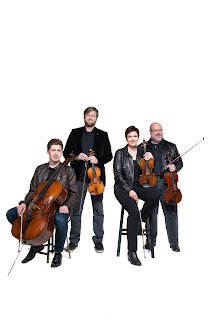Indianapolis Quartet comes to the north side with a Butler University composer's work
 |
| Based at the University of Indianapolis, the Indianapolis Quartet introduced itself to the north side. |
Felice, associate professor of composition, theory, and electronic music at Butler, based the work on five of his favorite children's books, each of its movements titled by a quotation from the book. "Five Whimsies" is the product of a commission from the New Century String Quartet in 2010. All sorts of credit must go to the composer for taking a risk that "whimsy" deserves stature as a formal label in the tradition of a capriccio.
 |
| Frank Felice spake again as a child in "Five Whimsies." |
"I'm in the milk, and the milk's in me," from Maurice Sendak's "The Night Kitchen," shows a contented lad inside a bottle of milk. How sensible it seemed, then, to hear a wash of imitative phrases passed around the quartet, suggesting the mutual absorption of child and beverage. Similarly, squeals counterpointed by anxious tremolos conveyed "Two weeks passed and it happened again" from Chris Van Allsburg's "The Mysteries of Harris Burdick," as it echoed the picture of an alarmed man raising a chair overhead and looking down at a lump under the rug.
The quartet — Zachary DePue and Joana Genova, violins; Michael Isaac Strauss, viola; Austin Huntington, cello — pursued Felice's whimsical expressions with vigorous commitment. It was a sign of the bright profile the musicians gave to each movement that "Great yawns are in blossom" (from "The Sleep Book" by Dr. Seuss) wasn't in the slightest soporific. After a sweet cello solo got things started, a viola passage nurtured another yawn blossom, and the ensemble's fine blend eventually found a snoozy resolution with a "good night" in harmonics.
"Five Whimsies" amounted to a fitting vehicle for the Indianapolis Quartet's first performance at Butler University. The Felice piece was substantially bookended by string quartets by Haydn and Mendelssohn. Opening the concert was the Austrian master's "Lark" Quartet (op. 64, no. 5 in D major).
After the work took flight living up to its nickname in the first movement, the Indianapolis Quartet showed its internal sensitivity with effective changes of pace at phrase ends in the "Adagio cantabile" second movement. Tempo adjustments weren't overdone, but put into service of the prevailing lyricism. The minuet movement was taken quite fast, pressing forward as if in anticipation of the "scherzo" designation that the minuet was to grow into; for many years, symphonic minuets were played too slowly, historians tell us. This one was properly brisk, with some bracing dynamic contrasts emphasized in the Trio. The fleet finale featured well-judged balances between the violins and the lower strings.
The Haydn quartet stemmed from a milestone year for the composer, 1790, as Haydn found release from aristocratic service to become a celebrated freelancer. Similarly, though the milestone was much less favorable, Mendelssohn's Quartet in F minor, op. 80, comes from his milestone year of 1847, which marked his premature death, preceded by that of his beloved sister. The F minor quartet is filled with tension and turmoil, commonly said to reflect Felix's mourning for Fanny. It's also been interpreted as the composer's premonitory sense that an era of classical restraint was about to end, because 1848 was to mark revolutionary upheaval across Europe.
Acceleration toward the end of the first movement was unanimously handled, capping the almost non-stop tension. The equally disturbing second movement established the uncanny atmosphere of someone walking in on a temper tantrum and perhaps tempted to beat a hasty retreat; lots of weight was loaded onto the foreboding Trio in this performance. I liked the buoyancy given to the third-movement respite from all this; the quartet did not press, but let the music float whenever it could. With the tension resuming, the finale seemed to indicate that moments of relief from extreme stress can be strategic; there was a sense of spontaneity, as if the musicians were figuring out how to build up to the next fit of released energy. They always succeeded, and the performance ended in a galvanic coda, hinting at a transcendence Mendelssohn was not to find in this life.



Comments
Post a Comment